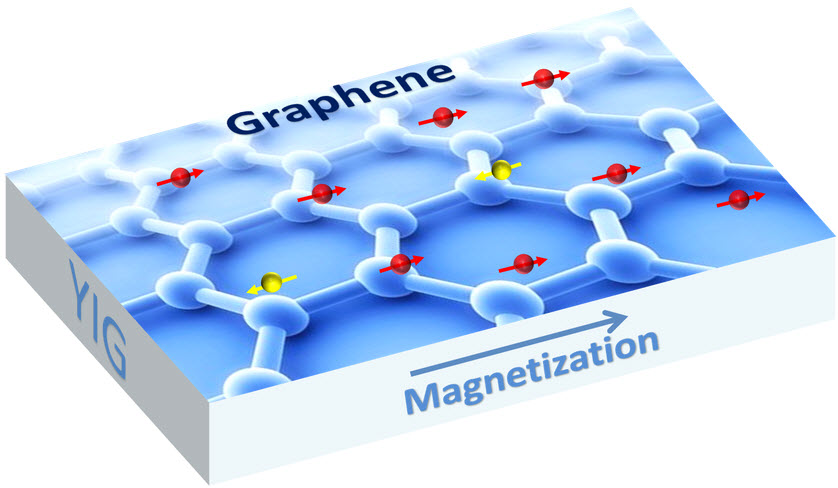Magnetic graphene created, making possible new spintronics data-storage devices
January 29, 2015

Graphene is a one-atom thick sheet of carbon atoms arranged in a hexagonal lattice. UC Riverside physicists have found a way to induce magnetism in graphene while also preserving graphene’s electronic properties (credit: Shi Lab, UC Riverside)
A team of physicists at the University of California, Riverside has found an ingenious way to induce magnetism in graphene while also preserving graphene’s electronic properties (conducting electricity).
They accomplished this by bringing a graphene sheet very close to yttrium iron garnet, a “magnetic insulator” (an electrical insulator with magnetic properties).*
Magnetic substances like iron tend to interfere with graphene’s electrical conduction. The researchers avoided those substances and chose yttrium iron garnet because they knew it also worked as an electric insulator, which meant that it would not disrupt graphene’s electrical transport properties.
By not doping the graphene sheet but simply placing it on the layer of yttrium iron garnet, they ensured that graphene’s excellent electrical transport properties remained unchanged.
New spintronics devices
“This is the first time that graphene has been made magnetic this way,” said Jing Shi, a professor of physics and astronomy, whose lab led the research. “The magnetic graphene acquires new electronic properties so that new quantum phenomena can arise. These properties can lead to new electronic devices that are more robust and multi-functional.”
For example, the finding has the potential to increase graphene’s use in computer chips that use spintronics (using electron spin and its associated magnetic moment to store data), the researchers say.
Study results appeared online earlier this month in Physical Review Letters. Grants to Shi and his team members from the U.S. Department of Energy and the National Science Foundation supported the research.
* The yttrium iron garnet was grown by laser molecular beam epitaxy in his lab. The researchers placed a single-layer graphene sheet on an atomically smooth layer of yttrium iron garnet. They found that yttrium iron garnet magnetized the graphene sheet. In other words, graphene simply borrows the magnetic properties from yttrium iron garnet.
In their experiments, Shi and his team exposed the graphene to an external magnetic field. They found that graphene’s Hall voltage — a voltage in a direction the perpendicular to the current flow — depended linearly on the magnetization of yttrium iron garnet (a phenomenon known as the anomalous Hall effect, seen in magnetic materials like iron and cobalt). This confirmed that their graphene sheet had turned magnetic.
Abstract for Proximity-induced ferromagnetism in graphene revealed by the anomalous hall effect
We demonstrate the anomalous Hall effect (AHE) in single-layer graphene exchange coupled to an atomically flat yttrium iron garnet (YIG) ferromagnetic thin film. The anomalous Hall conductance has magnitude of ∼0.09(2e2/h) at low temperatures and is measurable up to ∼300 K. Our observations indicate not only proximity-induced ferromagnetism in graphene/YIG with a large exchange interaction, but also enhanced spin-orbit coupling that is believed to be inherently weak in ideal graphene. The proximity-induced ferromagnetic order in graphene can lead to novel transport phenomena such as the quantized AHE which are potentially useful for spintronics.